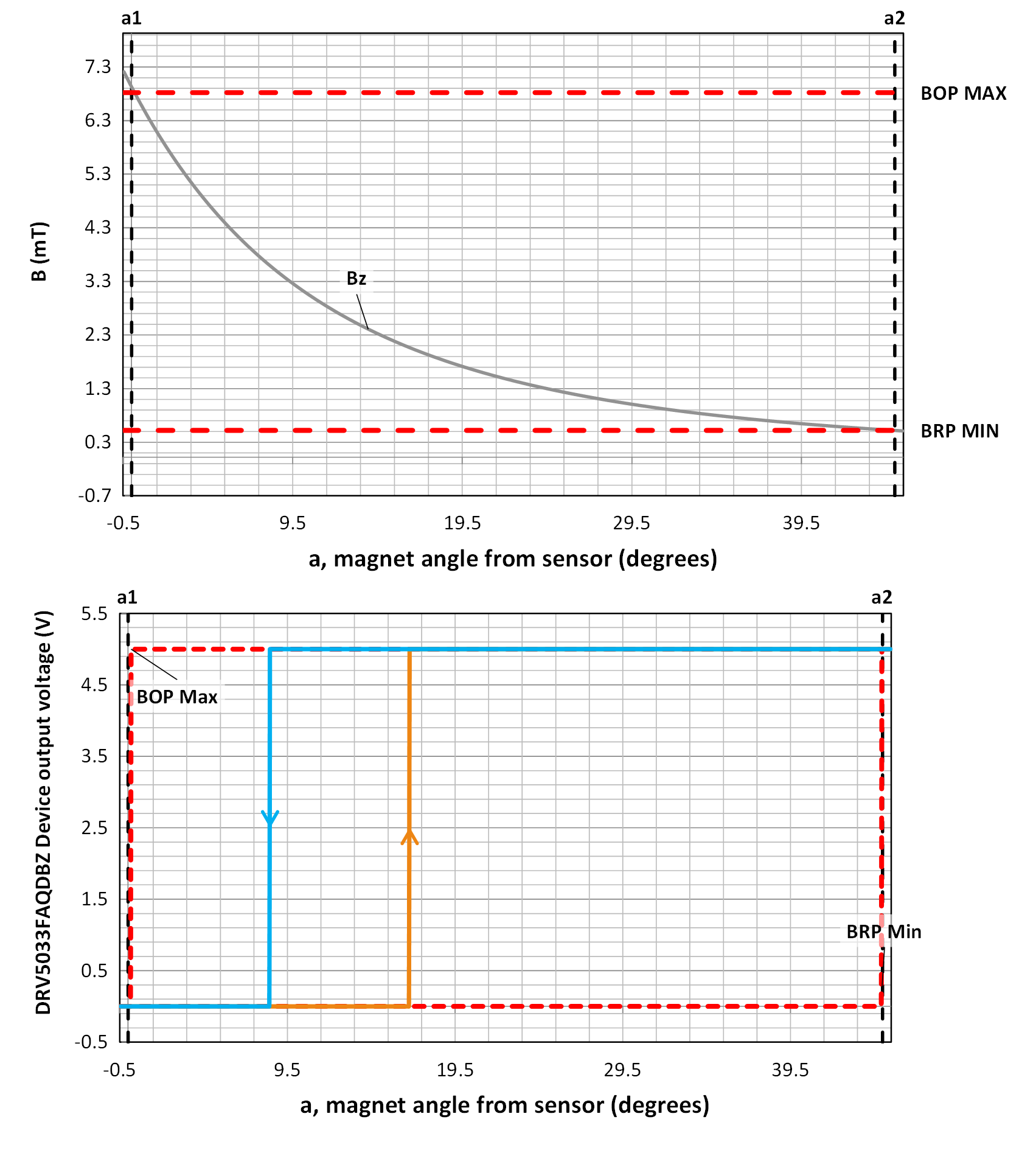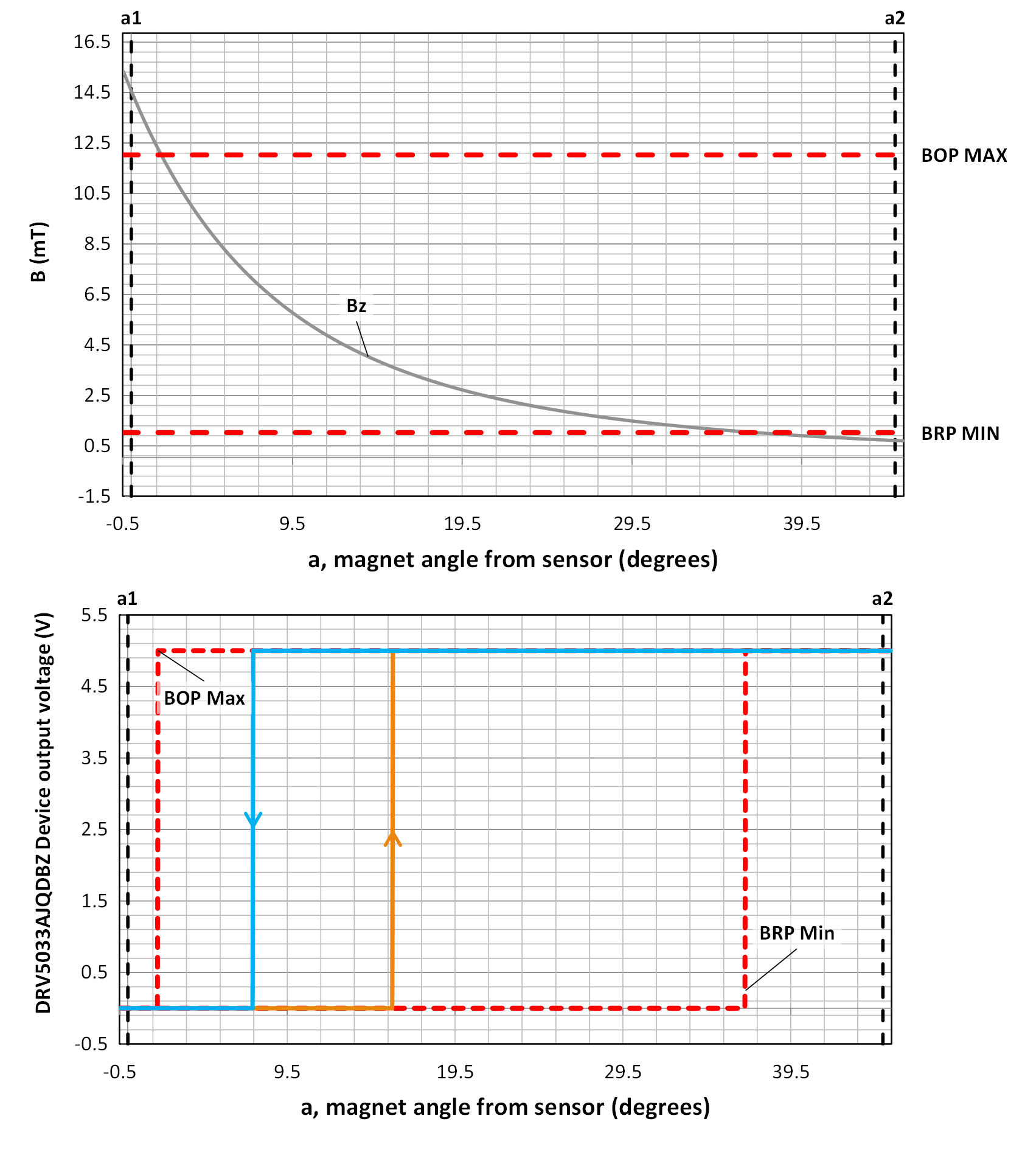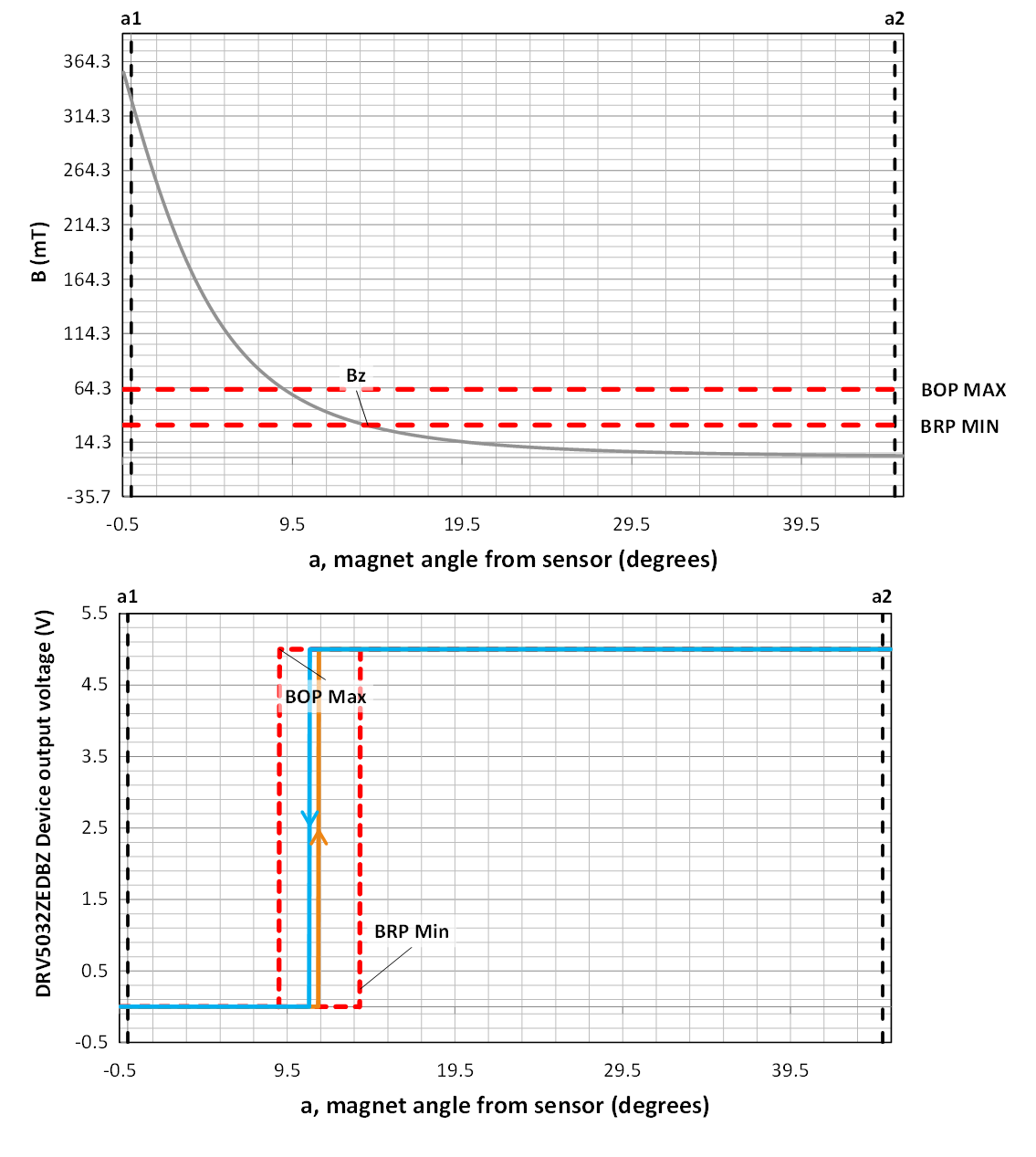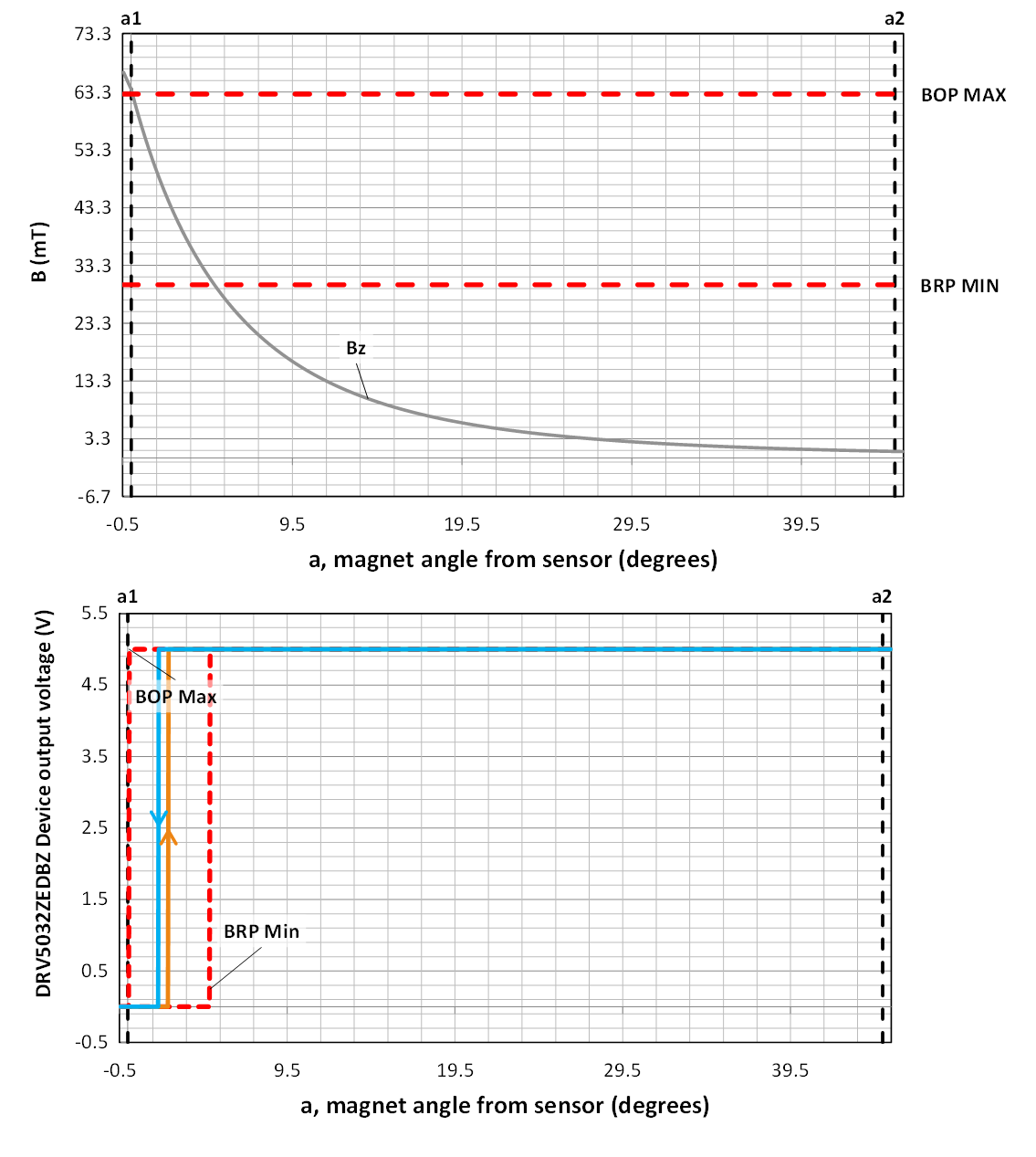SLIA096 January 2022 DRV5021 , DRV5021-Q1 , DRV5023 , DRV5023-Q1 , DRV5032 , DRV5033 , DRV5033-Q1 , TMAG5123 , TMAG5123-Q1 , TMAG5124 , TMAG5124-Q1 , TMAG5131-Q1 , TMAG5231 , TMAG5328
2.3 Magnet Sensor Placement
As a rocker switch will likely have a small form factor with its structure obscuring the magnet from the view of the end user, the magnet will likely be small and the smaller the magnet the weaker its field strength. As previously alluded to, offsets further from the magnet have weaker fields. Consequently, to have the device see the maximum field, align the magnet center to the Hall element center of the DUT when the switch is fully engaged and the magnet is parallel to the DUT.
To quickly get an idea of what might trigger the device, select a magnet that will fit within the switch structure shown in Figure 2-10 and run some calculations or simulations to see what distance is required. For calculations, leverage TI's Magnetic Sensing Proximity Tool. At the time of this writing, the smallest non-custom magnets readily available that are reasonably sized for the intended switch are Neodymium N42 magnets, which come in a form factor well below an inch. The smallest magnet found is 1/8 in × 1/8 in × 1/16 in (3.175 mm × 3.175 mm × 1.5875 mm). N42 is a quite strong magnet and several Hall-effect switches have trigger thresholds in the low mT range. Particularly, the BRP minimum threshold may be as low as 0.5 mT. This immediately raises the question of whether the rocker can move sufficiently far away in the rest state to fall below the BRP threshold.
Because the magnet moves in an arc, the hinge option for magnet movement is used in the tool. Subsequently, an educated guess is made on what might work within the bounds of the manufactured mechanical switch. Therefore, magnets and Hall-effect switches are placed at the locations indicated in Figure 2-11. This configuration is used because the modeled part can be quickly revised with parameterized dimensions in two locations, A and B. With TI’s Magnetic Sensing Proximity Tool, dimension A corresponds to Sensor Z-offset + device height (assumed to be 1.12 mm) while dimension B corresponds to Magnet Z-offset multiplied by –1 (due to the tool offset being based on the z-axis rather than the x-axis). Both of the dimensions are relevant to the hinge axis, which is the center of rocker switch axle. The final dimension is C, and this corresponds to the Arc Radius. This dimension is constrained by the desired switch width in the resting state. To simplify the design iterations, 13.5 mm is assumed.
To use TI’s Magnetic Sensing Proximity tool, a valid supply voltage value must still be entered, along with a type of device, and a device. A valid supply voltage is any voltage that is within the recommended operating range of at least one device in Texas Instrument’s Hall-effect position sensing portfolio. A voltage of 5 V would be reasonable here, but up to 38 V can be used for automotive-grade parts. As for the type of device, enter unipolar or omnipolar switch; however, keeping track of the polarity of the magnet for omnipolar switches is less necessary and therefore can simplify the manufacturing process. Upon selecting a device, the tool provides the option of selecting a package based upon the postfix of each specific part. Because a surface mount SOT-23 is used, look for part names ending in DBZ.
Having an automotive qualified offering, the DRV5033FAQDBZ is a reasonable first device to assess. The goal is to find the appropriate part and corresponding parameters in which BOP max and BRP min are bounded within a1 and a2 as shown in the middle graph in Figure 2-12. Ensuring BOP max and BRP min are within bounds, accounts for device variation and temperature drift in the design as the BOP and BRP thresholds for the device can deviate from the typical value, and in the worst case could be at the maximum or minimum values. If the field is too strong, the output graph will look similar to the left graph and it is possible some devices in the mass production of the system might not trigger high. Alternatively if the field is too weak, the tool voltage output graph will look like the right and some system production devices may never trigger low.
After a few iterations of manipulating the Sensor Z-Offset and the Magnet Z-Offset, suitable values were found that work according to the tool as indicated in Figure 2-13.
 Figure 2-13 DRV5033FA Preliminary Analysis
Figure 2-13 DRV5033FA Preliminary AnalysisAs Figure 2-13 shows, the device should trigger low just before the rocker reaches 0° for one of the active states and it should trigger high just before 45°, the boundary of the resting state. While this is good and accounts for device variation and temperature drift, it still does not provide a lot of margin, which might be necessary for system manufacturing tolerance. With system manufacturing tolerance the magnet may be offset in the mechanical switch structure, the Hall-effect switch may be offset on the PCB, or mechanical switch may be offset on PCB. With this in mind, a little more design margin is desirable and a different sensitivity variant, the DRV5033AJQDBZ with higher BOP and BRP thresholds, should be considered. The motivation for this is that a much smaller change in range would be required to trip both thresholds when considering the B-field graph characteristic. Figure 2-14 illustrates that an equal difference in BOP and BRP can have substantially different mechanical ranges depending on how high the thresholds are. If the magnet can be moved close enough to our Hall-effect switch, the field will be much stronger and the spatial hysteresis range for devices with relatively equivalent Bhys specifications will be much smaller.
After manipulating the sensor Z-offset variable some, a small improvement is seen in the margin as shown in Figure 2-15. This small improvement is not too surprising because the BRP minimum is only 0.5 mT higher and the typical hysteresis is larger for the DRV5033AJ.
 Figure 2-15 DRV5033AJ Preliminary Analysis
Figure 2-15 DRV5033AJ Preliminary AnalysisConsequently, another part is evaluated, the DRV5032ZEDBZ, which presently has the highest switch thresholds in the TI Hall-effect sensor portfolio with a BOP maximum of 63 mT and a BRP minimum of 30 mT.
 Figure 2-16 DRV5032ZE Preliminary Analysis
Figure 2-16 DRV5032ZE Preliminary AnalysisFigure 2-16 shows that the DRV5032ZE does seem quite promising. However, by exercising due diligence one problem is discovered. Because the magnet is small and a strong field is required, a low manufacturing tolerance must be assured. If the magnet x, y, and z offset tolerances are all +1.25 mm, then there might be systems in which the switch never triggers low as indicated in Figure 2-17. Consequently, if proceeding with this device, it might be a good idea to use a slightly larger magnet, with identical length and width dimensions, but a larger thickness.
 Figure 2-17 DRV5032ZE_Adjusted_Analysis
Figure 2-17 DRV5032ZE_Adjusted_Analysis| Specifications | DRV5033FA | DRV5033AJ | DRV5032ZE |
|---|---|---|---|
| Magnet Movement | Hinge | Hinge | Hinge |
| Magnet Shape | Block | Block | Block |
| Magnet Orientation | South Facing DUT | South Facing DUT | South Facing DUT |
| Magnet L | 3.175 mm | 3.175 mm | 3.175 mm |
| Magnet W | 3.175 mm | 3.175 mm | 3.175 mm |
| Magnet T | 1.5875 mm | 1.5875 mm | 1.5875 mm |
| Magnet Material | N42 | N42 | N42 |
| Br | 13000 G | 13000 G | 13000 G |
| a1 | 0° | 0° | 0° |
| a2 | 45° | 45° | 45° |
| X-Offset | 0 mm | 0 mm | 0 mm |
| Y-Offset | 0 mm | 0 mm | 0 mm |
| Sensor Z-Offset | –8.45 mm | -6.68 mm | –1.98 mm |
| Magnet Z-Offset | 1.21 mm | 1.21 mm | 1.21 mm |
| Arc Radius | 13.5 mm | 13.5 mm | 13.5 mm |
| VSupply | 5 V | 5 V | 5 V |
| Type of Device | DRV5033FAQDBZ | DRV5033AJQDBZ | DRV5032ZEDBZ |